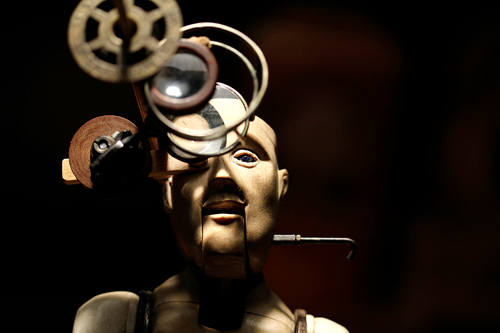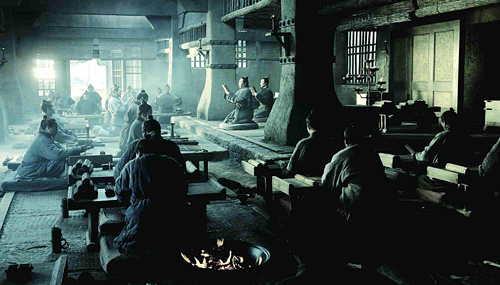In a culture that often demands explicit definitions for what qualifies as “art,” open-ended creative expressions of the human experience can be a breath of fresh air.
Films, fragments and figurines
In a culture that often demands explicit definitions for what qualifies as “art,” open-ended creative expressions of the human experience can be a breath of fresh air.

The Portland Art Museum is currently hosting an ongoing exhibition of artist John Frame’s animations and sculptures titled Three Fragments of a Lost Tale. The show, which will be on view through Sunday, May 27, consists of Frame’s photography, two of his short films and some hand-made figurines scattered about the gallery. Fragments is part one of an ambitious three-part project called The Tale of the Crippled Boy.
The museum presents the exhibition in almost total darkness with Frame’s figurines cast in small pools of light. The figurines are composed of natural and mechanical “found” objects, some of which were obtained from thrift stores and on the streets.
One figure, named “Mr. R,” is an eerie, comical and grotesque-looking sculpture of a man with rabbit ears stapled to a head made of steel, wood and stuffing. He holds a finger to his lips as though to silence the spectator, who has almost no choice but to gaze into Mr. R’s haunting wide-open eyes.
Frame has animated, written, assembled and composed every work in the exhibit. The figurines are brought to life in one of the films, a stop-motion short titled In Medias Res (a Latin phrase for “into the middle of things”), which has a dramatic violin-and-piano soundtrack.
The second film is an eight-minute mini-documentary titled Happy Medium, which Frame produced in collaboration with his friend Johnny Coffin. In Happy Medium, Frame explains his perceptions of art; how he views it, why art is important for him and for society, and how Fragments came into being.
Frame began making art in 1980 from a studio in Los Angeles, Calif. For 20 years, he incorporated his knack for imaginative carpentry into his work, but by 2005 he felt he had reached a brick wall in his inspiration.
“It was getting harder and harder to find a point of contact, a solid way to move forward,” Frame said. “Art should be a conversation you have with the world and with yourself and it wasn’t happening. I was getting ready to give it all up and go back to being a full-time carpenter.”
Days after Frame decided to abandon his art, he had a vivid waking dream in which he saw Fragments and its story in its entirety. He saw The Tale of the Crippled Boy and realized he had a new mission.
“I knew it was going to have to be animated, which I had never done before. It broke me free, and I have spent the last six years trying to recreate what I saw,” Frame said. “I have tried my best to respect [the project]—not commercialize it—and protect it.”
Art, according to Frame, should never have solid definitions. For this reason, there are no explanatory plaques underneath his figures, photos and films. The patron is forced to see themselves in his art and interpret it as they will.
“Most people love to ask me what it’s about when they see it, and I have answers for them when they do, but I do not feel the artistic circuit is closed until I can listen to my audience’s reaction to it and see it in their eyes,” Frame said.
Frame’s exhibition has been shown in only one other venue, California’s Huntington Library. While in residence, the show attracted over 30,000 visitors; it was expected to attract only 7,000. In Media Res has been shown in over 300 studios.
“The film has taken on a life of its own,” Frame said.
Frame is so opposed to commercialization that though he presented his work to DreamWorks producers, who were interested in possible collaborations, he refused any deals.
“I have a small following, and I love more people appreciating what I create, but that’s not what art is to me,” Frame said.
For an artist who has not traveled much until the nature of his project encouraged it, Frame was happy to come to Portland.
“I didn’t so much choose Portland as much as Portland chose me,” Frame said. “I have a strong interest in moving my studio to Portland anyway. I love weather and Portland has plenty of that, along with a great art community.”
Frame continues to create and develop Fragments, seeing it as a living, ongoing project. He will travel to Portland a handful of times during the coming spring to speak on his work. When the exhibition closes in May, he will return a final time to assist in its deconstruction.
“I always welcome people telling me what they got out of the exhibit and the film,” Frame said. “If I can touch even one or two peoples’ lives, make them better or change how they see the world, this project can really be complete.”
John Frame’s Three Fragments of a Lost Tale
On view through Sunday, May 27
$15 adults; $12 students w/ ID
Free for members and children 17 and under




